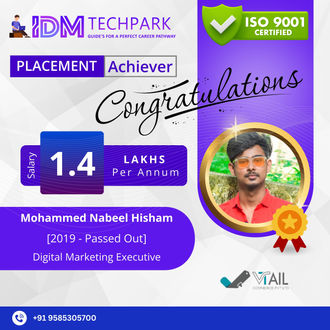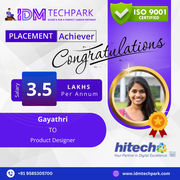
Home / GraphQL Course In IDM Techpark
GraphQL Course Training in Erode
"Learn to build efficient APIs with GraphQL, query data seamlessly, and optimize your development workflow. Join now to master GraphQL from an experienced expert and enhance your API development skills."
4.75 out of 5 based on 14525 votes
4.9/5
4.8/5
4.7/5
4.9/5
4.5/5
Live Project
Course Duration
80 Hrs.
2 Project
Training Format
Certification Pass
Guranteed
Live Online /Self-Paced/Classroom
Speciality
500 +
Professionals Trained
4 +
Batches every month
100+
Corporate Served
GraphQL Course in Erode
GraphQL is playing a key role in transforming data access by enabling flexible, efficient, and real-time querying of data. It allows organizations to request exactly the data they need, which improves application performance and supports more streamlined decision-making processes. This capability is particularly useful for business analysts, as it enables seamless integration of data sources, enhances collaboration between teams, and accelerates the process of driving insights and strategic initiatives.With applications in process automation, data analysis, and strategic decision-making, GraphQL is reshaping how business analysts work with data to optimize business operations, improve customer experiences, and ultimately achieve business goals. By embracing GraphQL, organizations can unlock the full potential of their data to drive innovation and growth.

Timings Doesn't Suit You ?
We can set up a batch at your convenient time.

Training Features of GraphQL course in Erode

Students Placements & Reviews
Skills You’ll Learn in GraphQL course in Erode
This GraphQL course at IDM Techpark in Coimbatore covers a wide range of skills, including:
PYTHON
SQL
MEACHINE
LEARNING
BIG DATA
DEEP
LEARNING
Tools Covered
By the end of the GraphQL course at IDM Techpark in Coimbatore, you'll have a powerful skill set at your fingertips, including tools such as:
TABLEAU
POWER BI
MATPLOTLIB
What are the skills required in GraphQL course?
Career Opportunities in GraphQL Course in Erode
GraphQL is a rapidly evolving technology that focuses on efficiently querying and managing data, enabling flexible and precise data retrieval to improve application performance and decision-making.
Who Can Enroll GraphQL Course in Erode?
There are no strict prerequisites to join the course. However, ideal candidates include:
GraphQL Course Fees & Enrollment
Flexible payment options available.
EMI and installment plans for easy accessibility.
Follow us on Instagram & Telegram for updates on new courses and discounts.
50+ Advanced Modules Covered
- 01
- 02
- 03
- 04
- 05
Course Highlights and Why GraphQL Course in Erode at IDM Techpark?
Comprehensive GraphQL Training – IDM Techpark provides expert training in GraphQL, covering schema design, efficient data querying, API development, real-time data fetching, and integration with front-end and back-end applications.
Industry-Aligned Curriculum – Our GraphQL course is designed by industry experts to provide a perfect blend of theory and hands-on experience. The curriculum covers GraphQL schema design, efficient data querying, API development, real-time data fetching, authentication & authorization, and integration with front-end and back-end technologies
Hands-on GraphQL Approach – IDM Techpark emphasizes practical sessions, enabling students to design and implement GraphQL APIs, optimize data queries, and integrate GraphQL with front-end and back-end technologies. Gain real-world experience in schema design, API development, and real-time data fetching using tools like Apollo Server, Apollo Client, Relay, and Express-GraphQL through hands-on projects and exercises.
Regular GraphQL Recap Sessions – IDM Techpark offers recap sessions after each class to reinforce key GraphQL concepts, ensuring students master schema design, efficient querying, API development, and real-time data fetching for real-world applications.
Flexible Batch Schedules – We offer weekday, weekend, and fast-track batches, enabling learners to choose training schedules that best suit their availability.
Real-Time GraphQL Project Exposure – IDM Techpark provides hands-on experience with live GraphQL projects, allowing students to design schemas, optimize queries, and integrate GraphQL with real-world applications for efficient data management.
100% Placement Assistance – IDM Techpark has partnerships with over 300 companies, offering placement support, resume building, mock interviews, and career guidance to help students secure high-paying jobs
GraphQL Course Objectives
-
Mastering GraphQL for Business Analysis – Build a strong foundation in GraphQL, covering key concepts in querying, schema design, and API optimization to enhance requirement gathering, business process modeling, data analysis, and stakeholder management.
-
Proficiency in GraphQL for Business Analytics – Learn to monitor, analyze, and visualize business performance by efficiently fetching and aggregating data with GraphQL, enabling seamless data integration and real-time reporting.
-
GraphQL Infrastructure Management & Solution Development – Understand GraphQL architecture, schema stitching, and federation to develop scalable solutions that optimize communication between business applications, ensuring efficient alignment of technology with business objectives.
-
GraphQL Techniques & Optimization – Explore best practices for query optimization, caching, and performance tuning, leveraging GraphQL subscriptions and mutations to drive workflow automation, data-driven decision-making, and business efficiency.
-
Automation & Solution Deployment with GraphQL – Learn to automate data fetching, manage API versioning, implement access control, and deploy GraphQL-powered business solutions that ensure reliable, scalable, and efficient operations, driving continuous improvement in business processes.
GraphQL Course Trainer Profile
Industry-Experienced GraphQL Experts – Learn from seasoned professionals with deep expertise in GraphQL, API design, data integration, and business process optimization, ensuring practical, real-world insights for effective implementation.
Comprehensive GraphQL Student Guidance – Our expert trainers mentor students in mastering GraphQL concepts, schema design, and API optimization, ensuring they can build efficient, data-driven solutions for business workflows.
Hands-on Practical GraphQL Training – Students gain real-time experience in GraphQL, mastering querying, schema design, and API optimization to streamline data integration and enhance business workflows.
Industry-Relevant GraphQL Tools – Instructors train students in essential GraphQL tools, including Apollo, GraphiQL, Postman, and Prisma, ensuring expertise in API development, data integration, and optimizing business workflows.
Regular Progress Assessments – Trainers conduct periodic evaluations and assessments to track each student's learning progress and provide necessary improvements.

Student Success Story of GraphQL Course in Erode
Aisha's Journey to Becoming a GraphQL Expert
Aisha, an MSc Computer Science graduate, initially worked in the technical support domain for a year. However, she soon realized that it wasn’t the right career path for her. Passionate about modern web development and API technologies, she decided to upskill and transition into a more technical role. After discussing her career goals with a friend and conducting thorough research, she discovered the power of GraphQL and its growing demand in the tech industry.
After exploring various learning options, Aisha chose IDM Techpark’s GraphQL Course, which provided specialized training in GraphQL schema design, querying techniques, API development, and performance optimization. The course covered hands-on experience with essential tools like Apollo Client, GraphiQL, Postman, and Prisma, ensuring a deep understanding of GraphQL’s capabilities in real-world applications. Since she was already employed, she opted for weekend classes to balance her job and studies effectively. With dedication and enthusiasm, she attended every session, mastering how to build scalable and efficient GraphQL APIs.
One of the key aspects of her learning journey was the hands-on experience she gained through real-world capstone projects. Under the mentorship of experienced trainers, she worked on GraphQL-powered applications, including designing schemas, optimizing queries, implementing authentication and authorization, and integrating GraphQL with databases and microservices. She also participated in API development challenges, case studies, and industry-relevant projects, helping her build a strong portfolio that showcased her expertise in modern API architecture.
Upon completing the course, Aisha took part in placement training provided by IDM Techpark. The training included resume building, mock interviews, GraphQL API problem-solving sessions, and coding assessments, which helped her gain confidence in facing technical interviews.
With her newly acquired skills and strong preparation, Aisha successfully cleared interviews with leading tech companies and startups, securing a GraphQL Developer role with a competitive salary package.
This opportunity marked the beginning of her successful journey in the tech industry, allowing her to work on impactful projects involving GraphQL APIs, performance optimization, and scalable backend architectures. Aisha’s story is a testament to the power of upskilling and perseverance. Her transition from a technical support role to a GraphQL professional proves that with the right training and determination, career transformation is possible. Today, she continues to grow in her field, leveraging her GraphQL expertise to build efficient, data-driven solutions for modern applications.

GraphQL Certification Training in Erode
Upon successfully completing the GraphQL Course at IDM Techpark in Erode, students will receive a prestigious certification from the institute. This certification serves as concrete proof of their expertise in GraphQL API development, validating their skills in schema design, querying, data fetching optimization, API security, and real-time data handling. It enhances their credibility in the job market, demonstrating their proficiency in building scalable, efficient, and high-performance GraphQL-based solutions.
The GraphQL Course at IDM Techpark is widely recognized by national and international organizations. Adding this certification to your resume will significantly boost your career prospects, making you a competitive candidate for roles such as GraphQL Developer, Backend Engineer, API Developer, Full-Stack Developer, and Software Engineer. The course aligns with industry best practices and incorporates cutting-edge tools such as Apollo Client, GraphiQL, Postman, Hasura, and Prisma, ensuring students are job-ready.
Under the expert guidance of our faculty, students will gain hands-on experience in designing GraphQL schemas, optimizing queries, implementing resolvers, managing API security, and integrating GraphQL with databases and microservices. They will also develop expertise in real-time data streaming, GraphQL subscriptions, and automation for efficient API development.
The course also covers critical topics such as API versioning, caching strategies, access control, and GraphQL best practices. The GraphQL Course at IDM Techpark is structured to enhance both technical skills and problem-solving abilities, empowering learners to excel in tech companies, startups, and enterprise development teams.
Earning this GraphQL certification will elevate your professional profile, unlocking exciting career opportunities in the rapidly evolving field of modern API development, full-stack engineering, and cloud-based application architecture.
Placement Session & Job Opportunities after completing GraphQL Course in Erode
Growing Demand for GraphQL Professionals – IDM Techpark, Erode
As businesses increasingly adopt modern API-driven architectures, the demand for skilled GraphQL developers is rising rapidly. Organizations need professionals who can design efficient GraphQL schemas, optimize queries, manage API integrations, and enhance data access to improve operational efficiency and drive business success in today’s fast-paced digital landscape.
-
This growing reliance on GraphQL for API development has created a surge in demand for experts proficient in schema stitching, API security, real-time data fetching, and tools like Apollo Client, GraphiQL, Postman, and Hasura.
-
GraphQL is not limited to tech firms—industries such as healthcare, finance, e-commerce, SaaS, gaming, and telecommunications are increasingly adopting GraphQL to streamline data access, optimize performance, and enhance developer experience. With expertise in query optimization, real-time data streaming, API authentication, and federated schemas, GraphQL professionals play a crucial role in building scalable, high-performance applications.
-
At IDM Techpark, Erode, we are committed to equipping students with industry-relevant GraphQL skills. Our comprehensive GraphQL Training Program ensures students gain practical knowledge through hands-on projects, real-world case studies, and expert mentorship. We also provide 100% placement assistance, helping students secure jobs in top tech firms and startups.
-
GraphQL developers are in high demand, with career opportunities in tech companies, SaaS enterprises, fintech startups, cloud-based platforms, and API-driven businesses. As modern web and mobile applications continue to evolve, expertise in GraphQL API development, microservices integration, and data fetching optimization will further enhance career prospects.
-
By enrolling in the GraphQL Course at IDM Techpark, Erode, students will gain hands-on experience, work on live GraphQL implementations, and learn best practices for API development. This ensures they are job-ready with the practical skills required to design, optimize, and deploy scalable GraphQL solutions.
-
GraphQL professionals enjoy competitive salaries, job stability, and flexibility, including opportunities to work remotely, freelance, or contribute to innovative API-driven startups.


























.png)



















